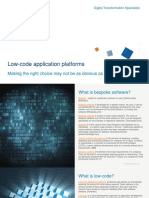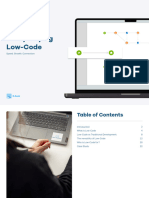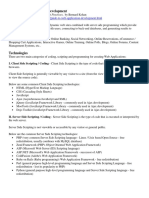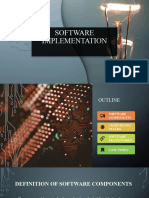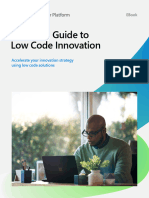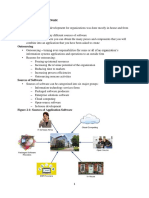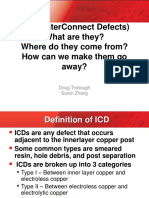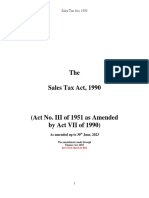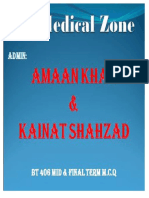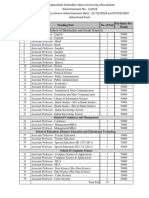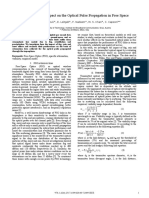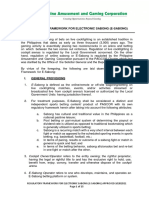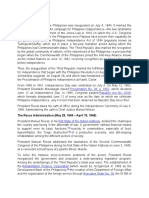Process Suite Platform - White Paper - Low-Code Development
Uploaded by
namanaProcess Suite Platform - White Paper - Low-Code Development
Uploaded by
namanaWhite paper
Low-code
development
Build applications more quickly and easily
through code reuse and simplified practices
This white paper presents an overview of the low-code
development capability in the new OpenText™ AppWorks
Application Platform. This low-code development
environment enables developers to more quickly and
easily build applications through code reuse and simplified
development practices.
Introduction 4
Contents
What is low-code? 4
Introduction to AppWorks Platform 4
Workspace 4
Projects 5
Documents 5
Sample projects 7
Information-centric low-code application development 8
Building blocks 8
Basic 9
Process flow 9
Business logic 9
Presentation 10
Content and collaboration 10
Integration with other information repositories 11
Imported entities 11
EIS entities 11
APIs 12
Technology connectors 13
Panels 13
Expression operators and functions 13
Building applications 13
A closer look at creating applications 14
Step 1: Create entities 14
Step 2: Establish the relationship between entities 14
Step 3: Add properties 14
Step 4: Create the user interface 14
Adding functionality to the application 14
Making application-level customizations 15
How a developer uses entity modeling to build a complex application 15
Process-centric low-code application development 15
Orchestration scenario 16
Model-assisted code-centric development 18
Low-code development 2/26
Contents Content systems integration: Document Store and Extended ECM 18
Standard domain model 20
APIs overview 21
Multi-tenancy and customization 21
Modeling and deploying mobile apps 22
Reporting, analytics and Artificial Intelligence 22
iHub 22
Process Intelligence 22
Magellan 23
Content storage considerations 23
Application deployment 23
Conclusion 23
Appendix A - Data domain models and properties 24
Identity component 24
Domain model overview 24
Domain model diagram 24
Detailed domain model of Person entity 25
Case Management Application Accelerator 25
Domain model overview 25
Help Topic domain model overview 26
Low-code development 3/26
Introduction
Applications vary from simple to complex and natively mobile to mobile-friendly, and
in each case, are defined as a self-contained, purpose-specific “program” that helps
end users interact with information from multiple systems to drive a business action
or outcome. A platform delivers the tools, capabilities and features a developer needs
to build an application, regardless of its complexity. This paper discusses the various
development approaches AppWorks supports and the tools and capabilities it
provides. In addition, it provides examples of how developers can leverage low-code to
build applications.
What is low-code?
Low-code is an emerging development approach that reduces the need for a developer
to write new code every time they build an application. Instead, low-code development
environments provide reusable, pre-built components with “drag and drop” capabilities
that minimize the coding effort and speed time to deployment. Using this simplified
approach, developers can more easily collaborate with subject matter experts throughout
the development process and business users can work on the application themselves,
reducing development cycles and the pull on IT resources.
Low-code can be used to build highly complex, enterprise-caliber applications. The OpenText
approach to low-code supports many development approaches including: information-
centric low-code, process-centric low-code, model-assisted coding and traditional
development. This empowers the professional developer to build the optimal application(s)
for their business. The focus of this white paper is on the three low-code approaches:
1. Information-centric low-code: Start by modeling the data and the data that resides
in the business, and then determine the lifecycle of the data and how this data flows
through the business
2. Process-centric low-code: Begin with the business process model and model the
processes executed in the business domain and then determine which systems, services
and actors are involved in the various processes
3. Model-assisted coding: Model applications using a separate IDE and then add generated
artifacts to the project along with other AppWorks models
Introduction to the AppWorks Platform
AppWorks provides a set of integrated components that help deliver seamless, reliable and
high-performance design and runtime environments for conducting enterprise business.
This section describes many of the platform components that are accessible to the
low-code developer. These components are presented in the order that a developer would
engage with them to build an application for the first time.
Workspace
A workspace is the starting point for the low-code developer. A workspace contains all
the projects with which a developer works.
In most organizations, there isn’t just one developer working in a workspace, but rather,
there is a development team. The platform supports various ways to configure workspaces
to support development teams. The best practice is to create a separate workspace for
each developer on the team, all connected to a common SVN source control repository.
Low-code development 4/26
When used this way, each developer has a separate workspace isolating their changes. SVN
allows standard version control so that developers can retrieve changes from others and
check in their changes to make them available to other developers.
Developers can also leverage applications from others in the Imported Application
Packages area. Developers do not have the source code for these packaged applications.
These may be purchased applications or applications from other teams in the same
enterprise. An example of an OpenText application that is available out of the box in the
Application Packages area is the Identity Package (see Standard domain model).
Projects
A workspace contains any number of projects. A project corresponds roughly to an
application. More specifically, a project is the unit of packaging and deploying1–a developer
can package a project that produces a file that can then be uploaded to a system and
deployed. This packaging concept supports best practices associated with governance of
applications2 (DTAP).
Projects can vary from simple to complex, depending on the type of application. The platform
provides options to help the developer organize their projects to make their applications easy
to maintain. The following example shows an application that has several projects.
Documents
A project contains a set of artifacts called documents. Many kinds of documents can be
added to a project and the list in the table below will continue to grow as new capabilities
are added to the platform. There are more than 60 document types, however many of them
are not frequently used and will be deprecated over time. The following table summarizes
the most frequently used and valuable document types.
1 Projects can also be referred to as a package. A package typically represents an application that has been deployed.
2 Controlling who can deploy to production, ensuring that the package deployed to production is the same as the
package that was tested, etc.
Low-code development 5/26
Entity modeling Document types used in information-centric, low-code applications
Entity Defines an entity. An entity represents a business object that is used by an
organization. See Information-centric low-code application development.
Home page layout Used to provide users with a landing page
Theme Defines a theme specifying the overall “look” of the end user interface
History log Defines a log file that tracks specific changes or access to items to maintain a
collection of history events
Process Document types used in process-centric, low-code applications
Business process model Defines a business process model
Business identifier Defines and uses business identifier
Decision table Defines a set of policies
Schedule Defines repeating business events
Developer Document types used in model-assisted and traditional applications
Cascading style sheet Adds a CSS file to a project
JavaScript Message Adds a JavaScript message bundle that can be localized to a project
Bundle
JavaScript source Adds a JavaScript source code file to a project
HTML source Adds an HTML file to a project
Java source Adds a Java source file to a project
Java archive Adds a Java archive (JAR) file to a project
Java class metadata Generates web services on a Java class
Web library definition 3
Adds a folder to manage web resources to a project
XML Adds an XML file to a project
XML schema Adds an XML schema file to a project
Developer Document types used to integrate with other systems4
EIS connector
5
Enables developers to create a connector (by writing Java code) to use data of an
external system as entities
EIS6 repository reference Defines a connection to a specific repository using an EIS connector
Specific EIS connectors Provides packaged EIS connectors for OpenText™ MBPM and OpenText™ Case360
Application connector Enables developers to create a connector (by writing Java code) to interact with an
external system through SOAP web services
Web service Creates a web service to access business logic from various sources such as
Database, WS-AppServer Package, external WSDL and Java classes
WS-AppServer Package Enables a developer to create web services by writing Java code. Commonly used to
develop web services on top of relational databases.
Database metadata Represents an imported database schema that can be used to import entities or
generate a WS-AppServer package
Developer Document types used to integrate with other systems4
Business calendar Defines a business calendar used to perform business day calculations
Role Defines a role to be used to control access to resources
3 This is also used with entity modeling to manage image resources.
4 There is some overlap with entity modeling, as the EIS document types also provide integration features.
5 Enterprise Information Service (EIS) entity connectors provide access to information in other systems.
6 Enterprise Information Service (EIS) entity connectors provide access to information in other systems.
Low-code development 6/26
In practice, while many projects are applications, some projects exist solely to define
artifacts (documents) that are shared and leveraged by other applications. For example,
the Identity Package is a project that is not an application in isolation, but provides artifacts
used by other projects.
Sample projects
As mentioned above, projects can vary from simple to complex, depending on the type of
application. For example, a simple application might have only one or two projects, whereas
a more complex application might include numerous projects. The following example shows
an expanded view of a low-code application structure. To help make complex projects
easier to maintain, developers create a common folder structure inside each project and
establish naming conventions in the beginning of the development cycle.
Common folder
structure
Business
process
models
Home page
layouts
Low-code development 7/26
Information-centric, low-code application development
AppWorks supports information-centric design by breathing new life into the proven
methodology of object-oriented programming with entity modeling. This approach is used in
cases where there is a clear view on how the business data is structured. With information-
centric design, developers first model the objects or entities that reside in the business
domain, then determine how they relate to each other and then specify the various pieces of
business logic for these entities and design how end users will interact with them.
An entity represents a business object that is used by an organization. For example, entities
for a case management application might be Case, Requestor or Priority. Entities are
typically related to each other, as when a Case is related to the Requestor (person) who has
made the request.
Entity modeling offers a compositional approach to application development. Instead of
programming certain pieces of functionality repeatedly, a developer defines the capabilities
of an entity by adding functional modules (called building blocks) to it and then configures
them to suit their needs.
Entity modeling offers low-code and compositional development capabilities that simplify
application development in various ways:
1. Introduces an intuitive way of modeling the business domain that is close to how the
subject matter expert conceptually thinks about it
2. Guides the subject matter expert when navigating through the domain model to express
business logic
3. Provides a simple way to add behavior to an application by enabling a subject matter
expert to select and configure functional modules (called building blocks)
4. Enables an application to access data that resides in an external system
With this approach, a developer can start by adding entities to their project. An entity is one
of the types of “documents” that can be added to a project. See Documents.
Building blocks
With an understanding of entities, a developer can start to think about other elements to
build onto their entities. These elements are called building blocks.
A building block adds pre-built functionality to an entity. Out of the box, AppWorks
provides a library of building blocks. For example, adding the Discussion building block to
an entity adds a threaded discussion form to it.
The following table describes the current set of building blocks. This list grows with each
release, as OpenText adds functionality to the platform.
Building blocks are categorized into the following areas:
• Basic
• Process flow
• Business logic
• Presentation
• Content and collaboration
Low-code development 8/26
The order in which a developer adds building blocks to entities is not pre-defined. In addition,
some building blocks, like History, can only be added to an entity once, while others can be
added any number of times, such as Properties and Forms.
Basic
Basic building blocks provide the foundation for an entity.
Building block Description
Property Adds a property to an entity. Properties can have various types (text, float,
enumeration, currency) and can specify constraints such as minimum value or pattern
Relationship Specifies a relationship from an entity to another entity. Relationships can be
one-to-one and one-to-many and many-to-many and peer-to-peer, as well as
parent-child
History Tracks changes to an instance of the entity in a history log (an audit trail)
Security Offers the ability to define a security policy that controls access to instances of an
entity and various building blocks specify permissions that can be granted to roles
in the security policy
Identity Adds properties that identify entity instances of the entity–all entities include this
building block
Process flow
Process flow building blocks define information about business processes.
Building block Description
Lifecycle Adds a lifecycle in the form of a set of linked states and activities to an entity,
making the entity into a case
Assignee Provides the ability to assign instances of the entity to individual participants or
roles, indicating some form of responsibility for that item
Activity flow Enables a designer to define simple sequences of tasks that can be added to a case
on an ad-hoc basis
Tracking Includes date/time created and last-modified and user who created/last modified
an instance of the entity
Business logic
Business logic building blocks define business logic and integration with other parts of
the platform.
Building block Description
Rule Adds a rule to an entity to specify business logic or a constraint or to create a
custom action
Web services Integrates an application with other systems or parts of the platform using web services
Deadline Tracks completion of various activities and objectives of an entity instance against
a deadline
Low-code development 9/26
Presentation
Presentation building blocks define the user interface for the application.
Building block Description
Layout Specifies an overall presentation of an instance of the entity. Multiple layouts
may be defined for use by different personas or different states of an instance of
the entity.
Form Specifies a presentation for the entity's (or related entity's) properties. Multiple
forms may be defined for use in different layout panels.
List Allows participants to access lists of instances of the entity. Any number of lists may
be added to an entity.
Title Adds a title that can be used to identify instances of the entity. Having a title on an
entity enhances the readability of history logs, etc.
Action bar Displays customized action buttons to users.
Mobile app Creates a mobile app based on the application. See Modeling and deploying
mobile apps.
Content and collaboration
Content and collaboration building blocks provide users with features to manage content
and communicate about items.
Building block Description
File Enables users to add a single file to an item and, with OpenText™ Content Server,
users have additional options, such as checking in and checking out versions of
an item
Content Offers the ability to associate any number of files with an entity instance
Business workspace Adds OpenText™ Extended ECM (xECM) functionality to the entity
Discussion Enables participants to conduct discussion associated with an entity instance
Email Allows the use of email in an entity, including both sending and receiving emails
from an entity instance
Email template Includes an email template with an entity that can be used to send emails with
embedded entity data
The following examples show how building blocks can extend the entity:
• Lifecycle: Includes many properties, including CurrentState and last performed task
• Relationships: Adds the CreatedBy and ModifiedBy relationships to User with tracking
• Behaviors: Ensures the associated file is deleted when an instance is deleted
• Actions: Adds a View History action
• Permissions: Provides permissions controlling who can upload or download the file
• Panels (UX): Adds Discussion to the Discussion Panel
• APIs: Adds the ContentStream REST Resource to upload/download file content
Low-code development 10/26
Integration with other information repositories
Applications are not created in a vacuum. In fact, an application is built to enable the
user to act on several types of information to address a specific issue (claims approval,
for example). Thus, applications must be designed to work well with existing information
repositories. AppWorks provides several standards-based or pre-built approaches for
building applications that leverage information from multiple repositories.
Imported entities
If the information needed by the application is accessible directly as a database table,
a developer can simply import the database table(s) into their project as entities. These
entities can then be used much like the entities created in the project7. If multiple tables
are imported, AppWorks will automatically define relationships between the tables from
the foreign key constraints in the database.
EIS entities
If the information needed by the application is only available through APIs, the developer
may choose to create an EIS connector for that repository. An EIS connector provides the
information from another repository to the project by adding appropriate entities to the
project. These EIS entities can be used much like the entities created in the project8.
The target external systems for a custom EIS connector include enterprise applications
(ERPs such as SAP®) and repositories (for example, SAP® SuccessFactors® or Microsoft®
SharePoint®). As each of these systems holds information, that information can be used
in an application. An application developer can focus on building their application without
having to create the connection to an information repository.
Order Case
management management
Enterprise
information
Content Archive
management management
People
management
The structure of an EIS entity is determined by the target repository and it cannot be
modified. That is, a developer cannot add, remove or modify its structured building blocks.
But they can add and modify presentation building blocks and build the user interface just
as they would for a native entity. Once the presentation is added, they can access an EIS
entity via OpenText™ Process Experience, just as they would access native entities.
7 The primary difference is that imported entities cannot be modified as OpenText does not own the table definition.
8 The primary difference is that EIS entities cannot be modified as they must conform to the information model in the
external repository.
Low-code development 11/26
Creating an EIS connector requires coding, but once the connector has been created,
a low-code developer can use them quite easily in their application. As explained in the
below diagram, EIS connectors developed for a particular system can be reused for
different instances of that system and can be reused by multiple applications that might
use different entities from this external repository.
1
Developer 1
Developer
• Define the entities and properties
• Implement the CRUDL operations in JAVA
• Package the EIS connector
2 3
Developer 2
Administrator Builder
• Deploy EIS connector on • Import EIS entities into project
builder’s environment • Decorate entities and use in application
• Configure connection properties • Package application
4 5
Production
Administrator Participant
• Deploy EIS connector and • Use the application
application packages • Perform CRUDL operations
• Configure connection properties
AppWorks provides a growing set of EIS connectors out of the box to support many
developer scenarios exposed via APIs, building blocks and web services.
To help customers move from other OpenText digital process automation (DPA) products,
EIS connectors have added capabilities. Out of the box, AppWorks provides connectors to:
• OpenText MBPM
• OpenText Case360
APIs
If the external system exposes an API that cannot be easily wrapped with an EIS connector,
the developer can use a business process model to retrieve information from the external
system or orchestrate transactions against it.9
API Description
SOAP AppWorks provides a set of SOAP APIs that a developer can expose for use by
coders creating applications that leverage low-code
Web AppWorks delivers a set of APIs that a developer can use in their application to
define its interaction patterns with the backend API, enabling an application to
communicate with the backend for processing information.
REST AppWorks includes a set of APIs that offers access to instances, task management
and Case activities/details
Entity REST AppWorks has an API that consists of URIs that identify resources on the server
where a developer can use the standard HTTP methods (the uniform interface).
9 All available APIs will be documented in a future release.
Low-code development 12/26
Technology connectors
AppWorks supports the following technology connectors that can be used to interact
with external systems:
• Database connector
• Document Store connector
• Email connector
• FTP connector
• Java connector
• SOAP connector
• REST connector
Panels
With this extensibility point, a developer can create panels to use in a layout. There are
two types of panels, entity instance and home page. Entity instance panels can only be
used on layouts on an entity. Home page panels may be used on both home page layouts
(dashboards) and entity layouts.
An entity instance panel can be configured so that it is only available in the layout designer
if a specific building block is present in the entity. As an example, the Tasks panel is only
available if the Lifecycle building block is present in the entity.
Expression operators and functions
Using this extensibility point, a developer can add operators and functions to the entity
expression language. Functions can have various implementations, including rule
expressions, web services and JavaScript.
Building applications
Before a developer begins building an application, they need to think about what they want
to build. It is important to think about what problems it needs to solve, what information
they need to collect and act on, what business processes they can automate, how users will
use it and what they need to see. Thinking in in this way, will help a developer build a solid
information-based application domain model.
The next step is to start building it.
A low-code developer can create an application in four steps.
Define the application
1 Create the entities needed for the application
2 Estabilish relationships between entities
3 Add properties to the entities
4 Create the user interface (Presentation) and add a form, list and layout
Publish the application
Low-code development 13/26
A closer look at creating applications
This section takes a closer look at the steps involved to create an application. Once an
application takes shape, a developer can add more functionality based on their requirements.
Step 1: Create entities
A developer begins creating an application by building entities. They must think of the
entities as the information they want to capture in their application. For example, an
automobile claims application might have Claim, Policy, Vehicle and Policy Holder entities.
A healthcare application might have Physician, Patient, Allergy and Medication entities. An
HR staffing application might have Job and Candidate entities.
Step 2: Establish the relationship between entities
Not all entities need to be related, but most of the time when building an application, one
or more of the entities are related in some way. So, after creating the entities they want in
their application, the developer must think about how they are related. For example, in an
automobile claims application, when a claim is created, the user needs to be able to select
the policy holder to create the claim. Therefore, the Claim entity must have a relationship
to Policy Holder.
Step 3: Add properties
After entities are defined, a developer can add properties to the entity. Properties in a
Claim entity in the automobile claims application might include, Date of Accident, Accident
Location and Driver.
Step 4: Create the user interface
Creating the user interface involves three steps that bring the application to life for users.
Typically, to begin, at least one of the following is added:
1. A form: Drag and drop the properties to design the form that users will use in
Process Experience
2. A layout: Design the layout with the panels for users to see. Often layouts display a form,
an action toolbar, breadcrumb panel and more (based upon the building blocks used in
the entity).
3. A list: Add the properties to display to users in the list. A list displays the existing entity
instances. For example, an All Jobs list in an HR staffing application would include a list
of all the job openings. This list might include properties, such as Job Title, Summary,
Date Opened and Hiring Manager.
Adding functionality to the application
With just four steps, an application begins to take shape. A developer can then think
about other functionality to add to the application. Options include:
• Business logic using rules
• The ability for users to attach files via the Content panel
• A workflow using the Lifecycle or Activity Flow
• The ability to show an audit trail using History
• Security permissions
• Collaboration capabilities using Discussion
Low-code development 14/26
At this point, a developer can leverage the pre-built functionality that comes in the
building blocks to extend the application to meet their needs. Most often, they won’t use
all building blocks in all entities. In a typical application, primary entities will include more
functional building blocks than supporting entities.
Making application-level customizations
All the above steps describe the functionality added to entities. However, functionality can
also be created and customized at the application level. For example, a developer might
apply their company’s color scheme with a custom theme, add their company logo to the
header or create a customized home (landing) page for users.
In addition to the customizations mentioned above, a developer can add a structured, long-
lived or short-lived business process to the application. These processes can interact with
web services and entities, allowing a developer to take advantage of any outside services
needed to accomplish their application requirements.
How a developer uses entity modeling to build a complex application
Applications can quickly become complex by the sheer number of items added to the
entities. Consider a simple application that has a few entities, five relationships to other
entities and only a handful of business rules. In a complex application, a single entity might
have 26 relationships and 30 to 35 business rules. In addition, complex applications often
include various structured, long-lived and short-lived business processes, integration with
external systems using web services and external user interfaces.
It is important for a developer to consider best practices when developing applications as
they often start out simple and then quickly grow complex. To help make the development
and application maintenance easier over time, a developer should define naming conventions
and project organization best practices before developing an application.
Process-centric low-code application development
With AppWorks, process-centric applications are created by adding one or more
business process model documents to a project. Developers edit these documents and
build a process model using a modeler that uses industry standard Business Process Model
and Notation (BPMN). AppWorks supports the industry-standard XPDL interchange format
to import and export BPMN processes from other systems.
Process-centric applications can be used to build applications that include the following
use cases:
• Orchestration is used to create services that, when called, perform a series of operations
against one or more other services. In this case, the process has few, if any, user activities.
• Structured human interaction is used when a business process is fully understood10 and
the developer wishes to completely control the way work is performed.
Most process-centric applications include aspects of both orchestration and structured
human interaction. Orchestration processes with no user interaction can be exposed
as web services, which can be called from external systems or used in other models.
Processes can use application connectors to interact with external systems. Out of
the box, AppWorks delivers connectors for HTTP (REST), FTP and JMS. There is also
a collection of community connectors that includes connectors for SAP and other
enterprise applications. Alternatively, developers can create a custom connector through
Java code, enabling interaction with any system exposing APIs.
10 One of the main pitfalls of this type of application is thinking the process is fully understood, when it is not. This is the
primary driver for more case-oriented application development where the participants have more control to deal with
edge conditions. In today’s world, applications with significant human interaction are usually implemented as case-
centric applications.
Low-code development 15/26
When users interact with process-centric applications, they usually do so via Process
Experience using the standard Inbox application included with the platform. In some cases,
an application-specific user interface is coded to provide a fully tailored user experience. In
other cases, there is no user interaction at all.
Orchestration scenario
Because businesses run diverse sets of information systems, often gathered through
various acquisitions, new applications must integrate with multiple existing systems.
AppWorks is designed to operate in this context. It provides connectivity for various
existing systems and a framework to build connectors for yet unsupported systems and
includes functionality to develop new applications.
Consider this following scenario: A company builds a solution to provide triple play
services to their customers. The solution needs to automate the entire chain from
taking the order on a website to activating the internet connection at home. Most of the
functionality is available in existing systems and these systems need to be integrated:
Siebel® for CRM, SAP for billing, a home-grown system for service engineer planning and
another proprietary system to handle the dispatching of physical goods, such as routers.
The following diagram depicts the environment.
Triple play delivery solution
Solution
External web SAP HTTP Custom EIS
services connector connector connector connector
JSON
SOAP
BIN
RFC
The solution comprises the following:
• The order entry form is implemented in ASP.NET, as the company has chosen to implement
the customer portal in ASP.NET.
• A set of related entities are created, including the Order entity, which is generated when
the customer submits the web form. The Order entity has a lifecycle that describes the
state and activities of the order.
• Some composite web services are implemented as short-lived processes to simplify
the interaction with Siebel and SAP from the Order lifecycle.
• An EIS connector is built to interact with the service to manage physical goods.
• User interfaces have been created for employees through Process Experience.
Given that every new customer needs to be registered in both Siebel and SAP, the developers
built a composite service on top of both products, implemented as a short-lived business
process, on top of both systems. The composite service is a regular SOAP web service that is
implemented through the model below.
Add customer Add customer
to Siebel to SAP
Low-code development 16/26
Since Siebel has a good web services interface, it is used for the integration. The web
service APIs are imported into AppWorks and invoked through the external web services
gateway (often called the UDDI connector). For SAP, the SAP connector is used. The required
BAPIs are imported into the platform and invoked from the business processes. The service
engineers planning system exposes a set of RESTful APIs, so the HTTP connector is used to
expose SOAP web services for these, which are again consumed in the business processes.
The physical goods service is totally proprietary and only exposes a Java API. The solution
developers implemented an EIS connector, which exposes the physical goods as entities, so
they can be related to the rest of the entity model.
The basic communication architecture of the platform resembles a bus, as depicted in the
following diagram.
External
system
Web
gateway
Repository DPA SSO
External web CWS LDAP CRM connector
services gateway
CARS CRM
External
system
All participants linked to the bus can exchange SOAP messages. Logically, there is a
central bus that links all participants, but technically, the communication is direct. The bus
framework knows the containers that provide the logical service, which of these containers
are available right now and whether these containers are properly functioning. Within that
set, the requests are load balanced and directly sent from sender to receiver.
DPA 1
CRM con 1 CRM con 2
CRM
Low-code development 17/26
Model-assisted code-centric development
AppWorks also supports model-assisted code-centric application development. In
this mode, most of the application is developed using a separate IDE and the artifacts
generated by the developer are added to a project along with other AppWorks models.
For example, a developer may use entity modeling to define a data domain that results
in a set of database tables, but prefers to implement the business logic using Java code.
All current AppWorks Data Domain models are contained in Appendix A: Data Domain
Models and Properties.
Each of the different approaches to application development may be combined to create
an application. For example, OpenText customer, Monster Energy created a fully custom
web experience for their partners, accessing entities defined in AppWorks via their
APIs. This is more of a hybrid approach, as the user interfaces for internal users of this
application are implemented using information-centric low-code tools.
Content systems integration: Document Store and Extended ECM
No matter which approach to application development a developer uses, it is critical
to integrate with content systems to manage the document content associated
with applications. To support this, AppWorks includes the Document Store service,
which provides a programmatic abstraction for generic document storage services. With
AppWorks, the configuration of the Document Store can be completed post-installation,
allowing the developer to focus on building a feature-rich application without worrying
about which document management system will be used to run the application. System
administrators can configure which document management system to use at runtime.
This abstract interface has multiple implementations, providing seamless integration to
Content Server, OpenText™ Core, OpenText™ Archive Server and OpenText™ Documentum™,
as well as an implementation on the standard CMIS interface that supports any compliant
CMIS 1.1 repository.
This underlying infrastructure is brought in with the entity/case low-code application
development tools via the File and Content building blocks that internally use the Document
Store connector. With the File building block, a developer can associate a single document
with an instance of an entity. With the Content building block, they can associate a
collection of documents with an instance of an entity.
Low-code development 18/26
Independent of Document Store, which provides generic integration to various content
repositories, the entity framework also provides Extended ECM integration using the
Business Workspace building block. This building block pairs an instance of the entity
with a Content Server Business Workspace using the Extended ECM infrastructure. This
provides an exceptionally seamless content experience when it is used in an application.
Process Platform ESP
Has
Connectivity framework
One of the implementation
Document Store connector
DMS plug-in framework
OTCS OpenText JSR-170
(OTDS) CMIS Core XDS Custom
(Jackrabbit)
OTAC CMIS 1.1
(OTDS) repositories
The Document Management capabilities are exposed to the developer in the following ways:
• Out-of-the box support for
• Content Server
• Archive Center
• Documentum
• OpenText Core
• CMIS 1.1 compliant repositories
• Jackrabbit and JSR 170 compliant repositories
• Extended ECM for AppWorks
• Creates workspace automatically when application objects are made
• Synchronizes application data with workspace based on events
• Manages workspace inside application through widgets
• Establishes relation between workspaces based on relation defined in application
• Supports business attachments
• Links with existing workspace in Content Server
• Shares same workspace created by leading application
Low-code development 19/26
Standard domain model
Virtually every application uses concepts like Person and Enterprise. To prevent developers
from having to repeatedly define these and to prevent users from needing to register
people and business partners in every application, AppWorks comes with a set of
predefined entities, in the form of the Identity Package. The most important entities are:
• Person: Represents a natural person. This entity can be used to represent a user,
employee, etc.
• Address: Persons and enterprises have an address, but the same entity can be used for
addresses of warehouses and stops for deliveries.
• Enterprise: Represents an organization. This entity is a subtype of Organizational unit,
thus inheriting the possibility to have people as members and to define a hierarchical
structure. It can be used to represent customers, suppliers, etc.
• Organizational unit: A unit of an organization. It defines a hierarchical structure and people
can be members of an organizational unit through assignments to positions in the unit.
• User: A user of the system. This entity is related to Person, basically giving that person
the role of user in the system.
• Group: This is a notion from the security system. Commonly, roles are synchronized
from an external identity management system, for example, Microsoft ® Active
Directory®, through OpenText™ Directory Services.
• Role: This is a security notion too. Roles are defined by applications and systems to
grant permissions to user personas.
The following diagram provides a high-level overview.
Besides these key entities, there are entities for phone number, email address, country
and state.
The entities in the Identity Package are provided for reuse by application developers. This
out-of-the-box domain model helps speed application modeling and, if used properly, also
reduces the administrative burden for users.
Explanations of all current data domain models and their properties are contained in
Appendix A: Data domain models and properties.
Low-code development 20/26
APIs overview
Within AppWorks, APIs are essential. Nearly every artifact in a project consumes or
provides services. A good example is a business process model, most processes are
themselves exposed as APIs that can be called and, of course, a business process model
can call other services.
Even a non-coding developer can produce APIs that can be consumed by others. Adding
APIs to an entity is a trivial operation that requires virtually no coding skills.
Every process and entity in an application extends the set of APIs available for creating
the next application.
Multi-tenancy and customization
AppWorks is a multi-tenant platform. Applications created through AppWorks can be
deployed for all tenants of the system or for a specific tenant. Even if the application is
deployed for all tenants, the data of the different tenants are strictly isolated from each
other. Tenants can have their own configurations and customizations of applications,
allowing them to tailor the system exactly to their needs. The multi-tenancy functions also
support deployment in a cloud scenario where some, but not all customers (or end users)
may need an application. For example, if you have four customers, an application might be
only installed for customer one, two and four, but not three.
With most applications on the market, customizations could block the road to upgrades,
as they modify the original application, making it impossible to accept newer versions from
the vendor. But in AppWorks, the customizations are kept separate from the application.
The customization is applied to the original application when running it. When the vendor
delivers a new version, the customizations can be applied on top of that.
Low-code development 21/26
Modeling and deploying mobile apps
AppWorks allows the mobile ‘micro’ apps to be modelled in the low-code design
environment and then deployed onto users’ devices. These apps expose elements of
the model: layouts, forms, lists and individual entities and allow the end user to remotely
participate in the process by creating new entity instances or performing actions on existing
entity instances to change their state.
The Mobile App building block is added to the entity’s model and configured as shown below.
The app can then be deployed and enabled automatically on the OpenText™ AppWorks
Gateway. It then becomes available to mobile users through the AppWorks mobile app.
Reporting, analytics and Artificial Intelligence
iHub
AppWorks provides a two-way integration with OpenText™ Information Hub (iHub).
First, for an application built in AppWorks, one can download a Data Object Design file,
which can be imported into OpenText™ Analytics Designer. This file contains the connection
details, data sources and relationships of the entities in the format used by Analytics
Designer. As a result, a report developer does not have to perform the data provisioning,
which is done automatically.
Second, AppWorks provides an iHub panel, which allows displaying an iHub report or
dashboard on a layout. If required, the iHub panel interacts with its context, as reports can
be filtered dynamically based on AppWorks data being displayed.
Process Intelligence
OpenText™ Process Intelligence provides operational status information and business
insights for digital business automation. As Process Intelligence has been built specifically
to support process-centric applications, its reports, dashboards and data exploration
capabilities provide complete visibility into your people and processes so you can optimize
activities to meet business objectives.
Low-code development 22/26
Process Intelligence leverages iHub so users can easily access the insight they need when
they need it. It provides pre-built reports that can even be customized to include dimensions
specific to the application built in AppWorks. This eliminates the complex task of building
business intelligence reports, which is typically performed by a data scientist.
Magellan
Through OpenText™ Magellan™, AppWorks provides applications with a pathway to AI,
machine learning, task automation and predictive analytics.
Massive amounts of structured and unstructured data from any source can be leveraged
and combined with AppWorks application data to enable machine-assisted decision-
making, automation and business optimization.
As Magellan comes up with findings and insights, it will deliver them through iHub reports
and dashboards to stakeholders in a visually compelling way that makes them easy to
understand and act on. With AppWorks’ iHub panel, these visualizations can be brought
back into the AppWorks application to have the insights where they need to be, with the
decision makers and knowledge workers.
Magellan can solve requirements specific to any solution built in AppWorks and digest case
management archives, employee records and similar unstructured documents to help find
more efficient processes, maintain SLAs, accurately rate employee effectiveness, manage
risk prudently or detect fraud, just to name a few examples.
Content storage considerations
A developer does not have to worry about whether their application will run in the cloud
or on-premises. They only need to build it once and can deploy it where they want–with no
extra steps. They only need to focus on how the application will work and what document
store (Content Suite, Core, xECM) to use.
Application deployment
When a developer completes an application, it will be initially deployed on the non-
production instance of the infrastructure for testing. Once approved, it will be moved
to the production instance. At that point, they can install, set up and commission the
application in their cloud infrastructure.
Conclusion
As organizations continue their digital transformation, developers face a lot of pressure to do
more, faster. The low-code application development platform will ensure developers thrive
under pressure. Now they can use a consistent look and feel and infrastructure and consistent
communication methods to build applications. With these capabilities, they can more quickly
create applications and more easily deliver features that help business users succeed.
About OpenText
OpenText, The Information Company™, enables organizations to gain insight through
market leading information management solutions, on-premises or in the cloud. For more
information about OpenText (NASDAQ: OTEX, TSX: OTEX) visit: opentext.com.
Connect with us:
• OpenText CEO Mark Barrenechea’s blog
• Twitter | LinkedIn | Facebook
Low-code development 23/26
Appendix A - Data domain models and properties
The sections in this appendix contain information on the following domain models:
• Identity component – Provided out of the box with AppWorks, it is automatically installed
and deployed and includes artifacts for the developer to leverage in their applications
• Case Management Application Accelerator – Available to developers to manually make
available and extend in their applications
• This appendix provides an overview of each domain model with a brief description of their
use. Detailed information on all properties of each entity shown in the following domain.
Identity component
Domain model overview
Most of the enterprise applications require common entities such as Person, User
and Enterprise. The purpose of this component is to provide such entities as part of
AppWorks itself so that multiple applications can use the same data set, avoiding the
data duplication for such entities in each application.
Apart from basic Entities like Person, User, Enterprise, Address, State and Country, the
Identity component provides entities to store organization structure-related information,
such as Organizational Units, Groups and Roles.
The Identity component also provides integration with OpenText Directory Services for
synchronizing user information and User/Group assignments in real time into Identity
component entities.
This package also provides APIs to access/update Personal and Organization structure
related information.
Domain model diagram
The Identity component domain model is split into two diagrams, one showing overall
domain model (without details on Person entity) and another one showing more detailed
diagram around Person entity.
Low-code development 24/26
Detailed domain model of Person entity
Case Management Application Accelerator
The Case Management Application Accelerator provides case management capabilities
that developers can extend to create a robust case management application. It also
includes knowledge management capabilities with the Help Topic data model. This allows
application developers to create their own application help to assist users.
Domain model overview
The Case Management application can automate a complex, unpredictable and unstructured
business process. It empowers knowledge workers to handle scenarios with dynamic and
unpredictable interactions between people, processes and content. Case Management offers
knowledge workers complete flexibility to intervene and decide the next course of action
in the process, to modify case progression and to initiate ad-hoc jobs based on the tasks
at hand. Case Management offers organizations flexibility to adapt processes according to
their business requirements. After a few iterations, organizations can further customize and
configure this generic system by means of enhancing or subtyping.
Low-code development 25/26
Help Topic domain model overview
The Help Topic Management component provides capabilities to manage Help articles in
various formats, for example, File, Text and Hyperlink to an existing webpage. This article
can be categorized and searched based on the keywords associated with the articles.
These modules also provide search and view capabilities, which other applications can
use to find content more quickly and easily and to help users find enough information for
a specific category or keyword.
opentext.com/contact
Copyright ©2018 Open Text. OpenText is a trademark or registered trademark of Open Text. The list of trademarks is not exhaustive of other trademarks.
Registered trademarks, product names, company names, brands and service names mentioned herein are property of Open Text. All rights reserved.
For more information, visit: http://www.opentext.com/2/global/site-copyright.html • (04/2018)09781.2EN 26/26
You might also like
- Sponsored DZ RC 288 Getting Started Low Code DevelNo ratings yetSponsored DZ RC 288 Getting Started Low Code Devel5 pages
- Low-Code Buyer's Guide For Enterprise Application DevelopmentNo ratings yetLow-Code Buyer's Guide For Enterprise Application Development16 pages
- Low-Code Application Platforms: Making The Right Choice May Not Be As Obvious As It SeemsNo ratings yetLow-Code Application Platforms: Making The Right Choice May Not Be As Obvious As It Seems13 pages
- Closetext WP Low Code Development Strategy enNo ratings yetClosetext WP Low Code Development Strategy en10 pages
- The Future of Software Development With Low-CodeNo ratings yetThe Future of Software Development With Low-Code19 pages
- OutSystems Low Code Supercharge App Development EbookNo ratings yetOutSystems Low Code Supercharge App Development Ebook13 pages
- Blackpaper Starter Guide To Low Code Development 2No ratings yetBlackpaper Starter Guide To Low Code Development 221 pages
- Taxonomy of Java Web Application FrameworksNo ratings yetTaxonomy of Java Web Application Frameworks8 pages
- Enterprise Low-Code App Development GuideNo ratings yetEnterprise Low-Code App Development Guide22 pages
- Comprehensive Guide to Software FrameworksNo ratings yetComprehensive Guide to Software Frameworks17 pages
- Unpacking Low-Code (White Paper - Plant An App)No ratings yetUnpacking Low-Code (White Paper - Plant An App)22 pages
- Introduction To Application Development and Emerging TechnologiesNo ratings yetIntroduction To Application Development and Emerging Technologies7 pages
- Microsoft Power Platform Partner Practice Low Code PlaybookNo ratings yetMicrosoft Power Platform Partner Practice Low Code Playbook70 pages
- Top Benefits of Using Low Code Platforms For Mobile App DevelopmentNo ratings yetTop Benefits of Using Low Code Platforms For Mobile App Development9 pages
- GrabnGo - Go Low Code With OutSystems - 220422No ratings yetGrabnGo - Go Low Code With OutSystems - 22042225 pages
- 54-MVC Framework-Intoduction To AngularJS-Directives-expressions-data Types-Module and Controllers-20-02-2023No ratings yet54-MVC Framework-Intoduction To AngularJS-Directives-expressions-data Types-Module and Controllers-20-02-202342 pages
- 3.a Survey of Low-CodeNo-Code Software Development Tools With AnNo ratings yet3.a Survey of Low-CodeNo-Code Software Development Tools With An20 pages
- 2021 - 2 - 11 - 145 - CL1-Adavanced Audit and Assurance-Feb 2021 - EnglishNo ratings yet2021 - 2 - 11 - 145 - CL1-Adavanced Audit and Assurance-Feb 2021 - English13 pages
- Automic - Automation 24.2.0 2024-10-23 Update-InformationNo ratings yetAutomic - Automation 24.2.0 2024-10-23 Update-Information4 pages
- Sample: Session 3 Extension Activity: Advanced Cropping TechniquesNo ratings yetSample: Session 3 Extension Activity: Advanced Cropping Techniques3 pages
- Icds (Interconnect Defects) What Are They? Where Do They Come From? How Can We Make Them Go Away?No ratings yetIcds (Interconnect Defects) What Are They? Where Do They Come From? How Can We Make Them Go Away?24 pages
- Module-23 - Nyquist Stability Criterion: EE3101-Control Systems EngineeringNo ratings yetModule-23 - Nyquist Stability Criterion: EE3101-Control Systems Engineering7 pages
- 6.OC and SC Test On Single Phase TransformerNo ratings yet6.OC and SC Test On Single Phase Transformer4 pages
- Ais655 Group 9 - Nacab6a - PBL - Sport LockerNo ratings yetAis655 Group 9 - Nacab6a - PBL - Sport Locker319 pages
- Content Theories - Maslow, Herzberg, AlderferNo ratings yetContent Theories - Maslow, Herzberg, Alderfer3 pages



